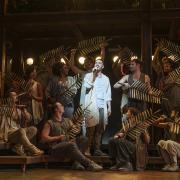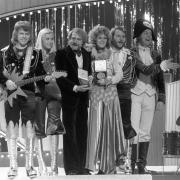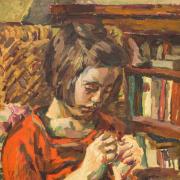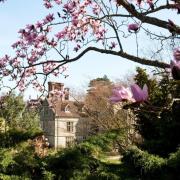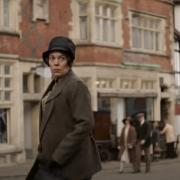Solution for the “Master of the Moon” piece by Tony Ward in the Sussex Life December issue
Who is it? Master of the Moon
Fearless eccentric, no amateur, no dinosaur
but equally irreplaceable,
the last of a generation.
Knight of the night sky,
his footprint on the moon.
.
Magic. Weaving his spell,
planting seeds in young minds,
a mission to inspire.
Apollo, Voyager, Pioneer.
Heroes met and heroes made, fact and fiction.
.
Researcher, observer, composer, performer –
twin loves. His mother’s gift,
his was no monocular vision.
.
A household name, father figure, cat protector,
his master’s lap the centre of Ptolemy’s universe.
Parties in the garden, nights to remember,
a generous host, Farthings’ rules.
Yet a household denied his first lost love,
substance and shadows.
.
Every minute filled, but forever in his thoughts
those unlived lives, until,
his daily paper uncollected, obituaries unread,
he’s there, his distance run.
.
For the party-goers, nectar and soda
at the pearly gates.
And that lost love, those unlived lives?
Our bodies die, we do not die,
not pointless, I’m sure she’s there.
Solution – Sir Patrick Moore CBE, FRS, FRAS – Amateur astronomer and musician
Explanation of embedded clues
Sir Patrick Alfred Caldwell-Moore CBE, FRS, FRAS (4 March 1923 – 9 December 2012) was a man of many talents - “his was no monocular vision” (his monocle, worn due to his right eye being weaker than his left, was one of his distinguishing features). He was an inspiring interpreter of modern astronomy, instantly recognisable, appealingly eccentric and widely respected. He was the presenter of the world’s longest-running television series with the same original presenter (721 Editions), the BBC’s The Sky at Night. The series was launched in the same year as Sputnik 1, 1957, and his last appearance was the week before his death in 2012.
In 1968 he moved into ‘Farthings’ in Selsey, West Sussex, a partly-thatched house complete with resident bats in the roof. Parts of the house date back to the 17th Century. One of his first tasks was to supervise the building of an observatory (later joined by another three) in his garden. His companions were his mother Gertrude, until her death aged 84 in 1981, a succession of much-loved cats and countless visitors and house-guests, always welcome. He was “a generous host”, “Farthings’ rules” (verse 4) refer to his insistence that guests just help themselves to drinks at all times without asking.
In the field of astronomy he was a widely respected researcher (“no amateur”), writer (70+ books), radio commentator, TV presenter and contributor, guest speaker and president of the British Astronomical Association. “Apollo, Voyager, Pioneer” are of course the names by which some of the American (NASA) space programmes were known, and upon which Moore commentated for BBC television. His lunar mapping was of great value to the moon missions and he acted as a consultant with both American and Soviet space programmes.
Also in the opening line of the poem, “no dinosaur” rebuts ill-judged remarks, perhaps from ‘new-broom’ television programmers, that he was ‘old-fashioned’, had become ‘a bit of a dinosaur’. He still typed his books and answered letters, at 90 words a minute, in the computer age, on his faithful 1908 Woodstock typewriter. He also abhorred metrification. His response to such criticism was typically pointed – ‘I may be accused of being a dinosaur, but I would remind you that dinosaurs ruled the earth for a very long time.’
“Heroes met” refers to his wide-ranging contacts. He was perhaps the only person to have met the first man to fly (Orville Wright), the first in space (Yuri Gagarin) and the first on the moon (Neil Armstrong). Armstrong’s fellow Apollo 11 moon-walker, Buzz Aldrin, was also later (2002) to present Moore with his special BAFTA Award for services to television. This echoed the citation for his 2001 Knighthood for ‘Services to the popularisation of science and to broadcasting.’ Another quote reveals another memorable encounter – ‘I’m only a four-dimensional creature. Haven’t got a clue how to visualise infinity. Even Einstein hadn’t. I know because I asked him.’
“Heroes made, fact and fiction” refers both to the fictional heroes he created in his science fiction novels for children and to those future leading lights in the field who were mesmerised by his “Magic” from an early age. He devoted a lot of time to “Weaving his spell,/ planting seeds in young minds,/ a mission to inspire”.
‘There are many individuals in successive generations of professional astronomers who owe a great deal to the books and personal support of Patrick Moore. He introduced children of all ages to astronomy, and some of them became prominent professionals in astrophysics and planetary sciences.” (Brian Warner, Emeritus Professor of Astronomy, University of Cape Town).
His other television persona was as the GamesMaster, 1992-1998 (126 episodes). He also appeared in a bewildering variety of radio and television programmes, from Panorama through Morecombe & Wise, Children in Need, Master Chef and as a panellist on a number of quiz programmes, to a cameo appearance on Doctor Who and a minor part in the fourth radio series of The Hitchhiker’s Guide to the Galaxy. Back in Sussex he was a keen amateur actor, appearing in local plays.
In addition to his Science Fiction novels for children he also wrote humorous works as ‘R. T. Fishall’. The poem title “Master of the Moon” is also the title of his first science fiction book for children, published in 1952. It was what he labelled ‘my first boys novel’. Moore’s particular field of interest was Moon observation, hence the poem title and the line “his footprint on the moon.” Of course his was a ‘virtual’ footprint, the real physical footprints were those of the Apollo 11 astronauts, Neil Armstrong and Buzz Aldrin.
“Composer, performer” refers to the fact that Moore was also an accomplished and knowledgeable musician. For the 1957 launch of The Sky at Night , an appropriate theme tune had to be chosen. He rejected the original proposal ‘You are my Lucky Star’ as ‘fluff’ in favour of the first movement of Jean Sibelius’s ‘Pelleas et Melisande : At the Castle Gate’. It became the permanent opener to the programme. He composed pieces for brass bands and piano and more than one opera. As a performer, his instruments were the xylophone, glockenspiel and piano. His sometime duettists included Evelyn Glennie, the profoundly deaf percussionist (also a xylophone player) and, as a pianist, surprisingly, Albert Einstein (violin). The latter event, on the occasion of their meeting in New York, was not recorded! Although not really into modern rock songs, he enjoyed a close friendship with (Dr.) Brian May, Queen guitarist and astrophysicist, who had first rushed out to buy all Sir Patrick’s books after his first viewing of The Sky at Night at about the age of ten. Later May was to become an occasional guest on the programme. The “twin loves” of music and astronomy, in Moore’s case “His mother’s gift”, were also shared by Chris Lintott, fellow Sky at Night presenter and opera composer - three astronomers, three musicians.
He was also a keen cricketer, a ‘quite dangerous medium-pace leg-break bowler’, and captain of his local team. Another enthusiasm was chess. He had represented Sussex in his youth and was vice-president of the Sussex Junior Chess Association.
Despite being “A household name” he unsparingly gave his time to others. He ‘adopted’ the four sons of friends who had died relatively young, and indeed was a kind of father figure or caring uncle to many of the youngsters to whom he had passed on his own love of astronomy. “Cat protector” refers to his love of cats and support of the Cats Protection charity. ‘Bonnie’, a stray black and white kitten, appeared in his garden one day asking to be adopted. ‘There was no arguing with that. A catless house is a soulless house’. Upon Bonnie’s death, nearly twenty years later, Ptolemy took her place. Moore chose the name. The phrase “the centre of Ptolemy’s universe” merits further explanation.
Claudius Ptolemy (cAD90 – cAD168) was a Greco-Egyptian mathematician and astronomer. He was the author of the Almagest, the only surviving comprehensive ancient treatise on astronomy. This was a forerunner to his later Planetary Hypothesis. In this Ptolemy expounded his geocentric (Earth-centred) theory of the universe. This ‘Ptolemaic Model’ became the accepted model of the universe for some 1400 years. It was gradually superseded, against strong theological opposition, by our true heliocentric (Sun-centred) model by Copernicus, Galileo and Kepler. But the centre of his feline namesake’s universe was surely Sir Patrick.
Despite his companion cats, his many visitors, the “Parties in the garden”, the “nights to remember”, there was always someone missing – “substance and shadows”. His fiancée, Lorna, a nurse, was killed at the age of 20 in a German air-raid on London in 1943. The ambulance that she was driving was struck by a bomb. It was three years after they first met. ‘That was it for me. There couldn’t be anybody else.’
The penultimate verse is concerned with Sir Patrick’s final days. The first and last phrases – “Every minute filled ... his distance run” is taken from the final verse of what was found to be the Nation’s Favourite Poem in a BBC poll taken in 1995, ‘If’ by Rudyard Kipling: ‘... If you can fill the unforgiving minute/ With sixty seconds’ worth of distance run/ Yours is the Earth and everything that’s in it,/ And – which is more – you’ll be a Man, my son!.’ The lines – “but forever in his thoughts/ those unlived lives,” of course refer back to Lorna. In an interview with the Daily Mail he revealed that rarely half an hour went by without his thinking of her. The other enclosed lines – “until,/ his daily paper uncollected, obituaries unread,/ he’s there” remind us of his humour, his tendency to poke fun at himself, and his enjoyment of the good-natured ribbing he sometimes invited. The quote that he picked up on was originally that of Mark Twain – ‘I get my copy of the daily paper, look at the obituaries page, and if I’m not there, I carry on as usual.’ In editions after 12:25 on the afternoon of 9th December 2012, he was there. He died peacefully at his home, Farthings, in the company of close friends and carers, and of course his cat Ptolemy.
But that was not the end. There is still the final verse. He thought that funerals were a waste of time and so he left money in his will to have a party, with musical accompaniment from one of his own compositions. It was of course to be a ‘Farthings Rules’ occasion, to be extended in due course to the”pearly gates” where he would welcome them with “nectar and soda”.
The last three lines document his belief in an after-life, in a chance to be reunited with Lorna.
‘I don’t believe partings are for ever. If we die when our bodies do, then everything would be pointless. And the universe is not pointless. The next stage? Oh, I’m sure she’s there.’
Acknowledgement of sources
• Patrick Moore: The Autobiography, Patrick Moore, The History Press, 2005 (The original version was published under the title 80 not out: The Autobiography, 2003).
• The Nation’s Favourite Poems, Foreword by Griff Rhys Jones, BBC, 1996.
• en.wikipedia.org/wiki/Patrick_Moore
• banguniverse.com (an interactive website set up by Brian May, Patrick Moore and Chris Lintott to stimulate constructive discussion of the astronomical topics raised in their jointly-authored books - Bang! The Complete History of the Universe, 2006, and The Cosmic Tourist, 2012. The website also has a link to the ‘Sir Patrick Moore Memorial Website’ containing many moving personal tributes to Sir Patrick as well as ‘Latest News’ features).
• www.bbc.co.uk/news/uk-20657939 (‘Sir Patrick Moore, astronomer and broadcaster, dies aged 89’, posted 9 December 2012. This also has 3 video clips embedded).
• www.dailymail.co.uk/news/article-2245616 (a particularly enjoyable obituary by Glenys Roberts).
• www.youtube.com/watch?v=6t0exJznEZg ( Sir Patrick Moore’s final episode of The Sky at Night – Reaching For The Stars 06-01-2013 (20 minutes). This was mostly filmed in the garden of his house ‘Farthings’ in Selsey, ‘within the sound of the sea’. YouTube then continues on to the 2-hour BBC 2008 Sky at Night Moon Special ‘Apollo: A night to remember’. Sir Patrick was one of the presenters. The night was 16th July 1969, the launch of Apollo 11, the first manned flight to the Moon. The programme is prefaced by an extract from President Kennedy’s historic 25th May 1961 speech committing the USA to sending a man to the Moon.).
• www.youtube.com/watch?v=8ZF4qyOPrcU (The Sky at Night – TV theme tune, the first movement from ‘Pelleas et Melisande: At the Castle Gate’ by Jean Sibelius).
• Relevant websites found by searches for ‘Sir Patrick Moore’, ‘Ptolemy’, ‘Farthings, Selsey’, ‘Sir Patrick Moore quotes’, ‘Sir Patrick Moore obituaries’, ‘Sir Patrick Moore gamesmaster’, ‘Sir Patrick Moore xylophone’, ‘Brian May and the Sky at Night’, ‘The Master of the Moon by Patrick Moore’, ‘At the Castle Gate’.



